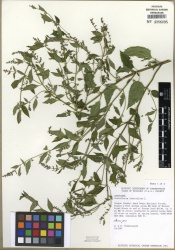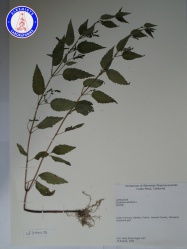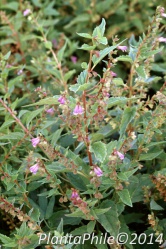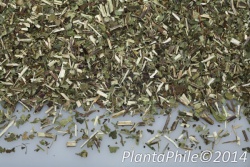Scutellaria lateriflora (flower)
(→updates to ABC-AHP-NCNPR Botanical Adulterants Prevention Program program title) |
|||
| (10 intermediate revisions by 2 users not shown) | |||
| Line 1: | Line 1: | ||
| − | = | + | {{DISPLAYTITLE:''Scuntellaria lateriflora'' (flower) }} {{askbox|herb=''Scutellaria lateriflora''}} |
| + | =Nomenclature= | ||
| + | {{nomenclature | binomial=Scutellaria lateriflora | ||
| + | |authority=L. | ||
| + | |family=Lamiaceae | ||
| + | |scn=skullcap | ||
| + | |syn= | ||
| + | |ayurvedic= | ||
| + | |pinyin= | ||
| + | |aka=blue skullcap; scullcap | ||
| + | |notes= }} | ||
| − | + | =Botanical Voucher Specimen= | |
| − | + | {{Media2 | cat=Voucher | |
| − | + | | source=MOBOT, Tropicos.org | |
| + | | mainimage=Scutellaria_lateriflora_Tropicos_100007266.jpg | ||
| + | | companyimage=TropicosLogo.gif | ||
| + | | companyURL=http://www.tropicos.org/Image/100007266 | ||
| + | | reference=Tropicos.org. Missouri Botanical Garden. 26 Mar 2014 <http://www.tropicos.org/Image/100007266> | ||
| − | = | + | | source2=Botanical Voucher Specimen Library, Alkemists Laboratories |
| + | | image2=Scutellaria lateriflora LE31406JD A0272.jpg | ||
| + | | companyimage2=AP-LOGO-Laboratories Crop - Copy.jpg | ||
| + | | companyURL2=http://www.alkemist.com | ||
| − | |||
| − | |||
| − | |||
| − | |||
| − | |||
| − | |||
| }} | | }} | ||
| − | |||
| − | = | + | =Organoleptic Characteristics= |
| + | {| border=1 | ||
| + | | | ||
| + | {{Organolepsy | source=United States Dispensatory (1918) | ||
| + | | description=Odor slight; taste slightly bitter. }} | ||
| + | |} | ||
| − | = | + | =Macroscopic Characteristics= |
| + | {| border=1 | ||
| + | | | ||
| + | {{Macroscopy | source=American Medicinal Plants of Commercial Importance (1930) | ||
| + | | description=This plant is smooth or with very fine hair on the upper parts with slender, erect or declining, widely branched stems from one-third to 2 1/2 feet high. The thin, slender-stemmed leaves are somewhat lance-shaped or egg-shaped, 1 to 3 inches long, and coarsely toothed. The blue and whitish, tube shaped flowers appear from July to September. | ||
| + | }} | ||
| + | {{Macroscopy | source=United States Dispensatory (1918) | ||
| + | | description=''Scutellaria lateriflora'' is an indigenous, perennial herb, with a stem erect, much branched, quadrangular, smooth, and one or two feet high. The leaves are ovate, acute, dentate, subcordate upon the stem, opposite, and supported upon long petioles. The flowers are small, of a pale blue color, and disposed in long, lateral, 1-sided, leafy racemes. | ||
| + | |||
| + | Dried tops are ... about 50 cm. in length, smooth; stem quadrangular, branched; leaves opposite, petiolate, about 5 cm. in length, ovate-lanceolate or ovate-oblong, serrate; flowers about 6 mm. in length, in axillary one-sided racemes, with a pale blue corolla and bilabiate calyx, closed in fruit, the upper lip helmet-shaped.}} | ||
| + | |||
| + | {{ Media2 | cat=Macroscopy | ||
| + | | source=PlantaPhile | ||
| + | | mainimage=PlantaPhile - 570.jpg | ||
| + | | companyimage=PlantaPhile logo.jpg | ||
| + | | companyURL=http://plantaphile.com/ | ||
| + | |||
| + | | source2=PlantaPhile | ||
| + | | image2=PlantaPhile - 3067.jpg | ||
| + | | companyimage2=PlantaPhile logo.jpg | ||
| + | | companyURL2=http://plantaphile.com/ | ||
| + | | }} | ||
| + | |} | ||
| + | |||
| + | =Microscopic Characteristics= | ||
| + | |||
| + | =High Performance Thin Layer Chromatographic Identification= | ||
| + | |||
| + | =Supplementary Information= | ||
| + | |||
| + | == ABC-AHP-NCNPR Botanical Adulterants Prevention Program Laboratory Guidance == | ||
| + | {{Botanical | source=ABC-AHP-NCNPR Botanical Adulterants Prevention Program | ||
| + | | companyimage=BAPP-logo-2018-2line-LOW2.jpg | ||
| + | | companyURL=http://cms.herbalgram.org/BAP/LGD/SkullcapLabGuidanceDocument.html | ||
| + | | description=Skullcap (herb) (''Scutellaria lateriflora'') | ||
| + | | characteristics=This ABC-AHP-NCNPR Botanical Adulterants Prevention Program [http://cms.herbalgram.org/BAP/LGD/SkullcapLabGuidanceDocument.html Laboratory Guidance Document] presents an overview and comparison of various analytical technologies and methods used to differentiate between authentic skullcap ingredients and non-authentic materials, with particular discussion of ''Scutellaria'' and/or germander ''Teucrium'' substitutions. Differences in flavonoid compositions are reviewed, and a variety of methods for authentication considered (including sample characterization via HPTLC, HPLC, UPLC, MS fingerprinting, NMR, and Near-IR hyperspectral imaging). | ||
| + | }} | ||
| + | |||
| + | == AHPA Known Adulterants List == | ||
{{Botanical | source=AHPA Known Adulterants | {{Botanical | source=AHPA Known Adulterants | ||
| companyimage=AHPA Logo.gif | | companyimage=AHPA Logo.gif | ||
| Line 30: | Line 83: | ||
| adulterants=Germander (''Teucrium chamaedrys'') flowering parts. | | adulterants=Germander (''Teucrium chamaedrys'') flowering parts. | ||
}} | }} | ||
| + | =Sources= | ||
| + | <references /> | ||
Latest revision as of 17:19, 17 October 2018
Contents |
Nomenclature
Scutellaria lateriflora L. Lamiaceae
Standardized common name (English): skullcap
Botanical Voucher Specimen
 |
|
|
|
|
Organoleptic Characteristics
|
Macroscopic Characteristics
|
Microscopic Characteristics
High Performance Thin Layer Chromatographic Identification
Supplementary Information
ABC-AHP-NCNPR Botanical Adulterants Prevention Program Laboratory Guidance
Skullcap (herb) (Scutellaria lateriflora)
General Characteristics This ABC-AHP-NCNPR Botanical Adulterants Prevention Program Laboratory Guidance Document presents an overview and comparison of various analytical technologies and methods used to differentiate between authentic skullcap ingredients and non-authentic materials, with particular discussion of Scutellaria and/or germander Teucrium substitutions. Differences in flavonoid compositions are reviewed, and a variety of methods for authentication considered (including sample characterization via HPTLC, HPLC, UPLC, MS fingerprinting, NMR, and Near-IR hyperspectral imaging).
Source: ABC-AHP-NCNPR Botanical Adulterants Prevention Program [8]
AHPA Known Adulterants List
Skullcap (flowering parts) (Scutellaria lateriflora)
General Characteristics AHPA recommends in its Known Adulterants list that appropriate steps be taken to assure that this raw material is free of the noted adulterant. Contact AHPA for additional information regarding relevant analytical methods or follow this link for more information.
Reported Adulterants Germander (Teucrium chamaedrys) flowering parts.
Source: AHPA Known Adulterants [9]
Sources
- ↑ MOBOT, Tropicos.org http://www.tropicos.org/Image/100007266
- ↑ Botanical Voucher Specimen Library, Alkemists Laboratories http://www.alkemist.com
- ↑ United States Dispensatory (1918)
- ↑ American Medicinal Plants of Commercial Importance (1930)
- ↑ United States Dispensatory (1918)
- ↑ PlantaPhile http://plantaphile.com/
- ↑ PlantaPhile http://plantaphile.com/
- ↑ ABC-AHP-NCNPR Botanical Adulterants Prevention Program http://cms.herbalgram.org/BAP/LGD/SkullcapLabGuidanceDocument.html
- ↑ AHPA Known Adulterants http://www.ahpa.org/
- Botanical
- Lamiaceae
- Media
- Voucher
- MOBOT, Tropicos.org
- Botanical Voucher Specimen Library, Alkemists Laboratories
- Organolepsy
- United States Dispensatory (1918)
- Macroscopy
- American Medicinal Plants of Commercial Importance (1930)
- PlantaPhile
- ABC-AHP-NCNPR Botanical Adulterants Prevention Program
- AHPA Known Adulterants



